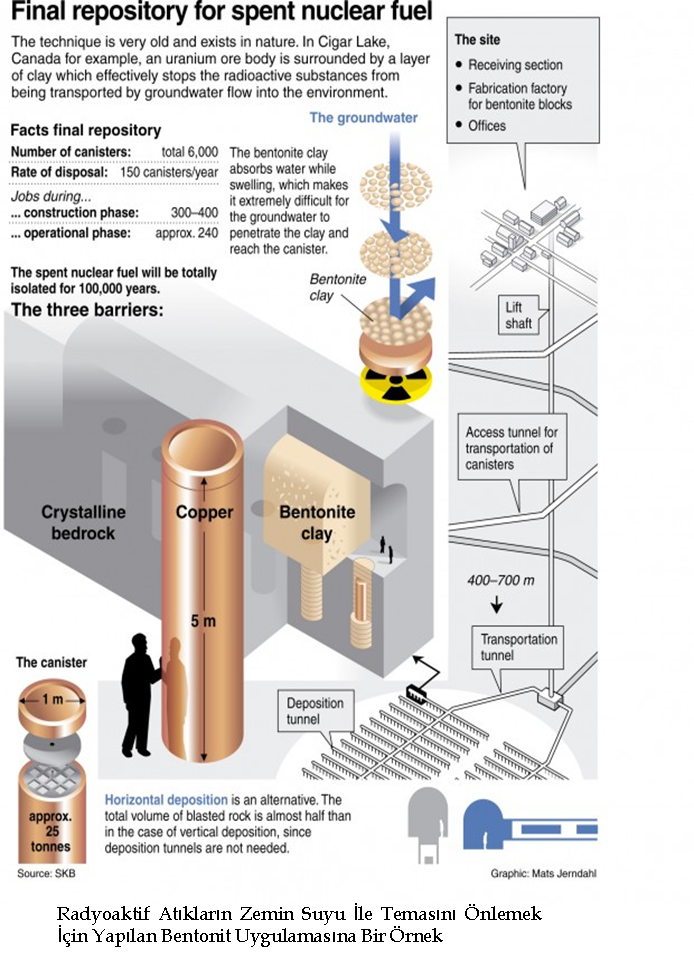Bentonitin Nükleer Atıkların Bertaraf Edilmesinde Kullanımı
Yapılan bir diğer çalışmada, Bentonit bazlı malzemelerin birçok ülkede nükleer atıkların bertaraf edilmesinde bariyer ve engelleyici malzeme olarak kullanıldığı, bunların birçoğu sodyum tip iken, Kore’de ise Kalsiyum tip Bentonitin yaygın olduğu belirtilmiş, bu bağlamda Kalsiyum Bentonitin ilgili konuda özellikleri incelenmiştir.
Yapılan incelemeler, testler neticesinde elde edilen sonuçlara göre; Kore’de mevcut olan Kalsiyum tip Bentonitin potansiyel açıdan nükleer atıkların bertaraf edilmesi ve depolanmasında bariyer malzemesi olarak kullanılabileceği ifade edilmiştir. Aynı zamanda elde edilen verilerin bu tür atıkların depolanması için yapılacak mühendislik tasarımları ve geliştirilecek uygulamalarda güvenlik şartlarına uygun olması için katkıda bulunabileceği belirtilmiştir.
Çalışmanın İngilizce özetine aşağıda yer verilmiştir.
 Experimental Assessment Of Non-treated Bentonite As The Buffer Material Of A Radioactive Waste Repository.
Experimental Assessment Of Non-treated Bentonite As The Buffer Material Of A Radioactive Waste Repository.
Choi J, Kang CH, Whang J.
Korea Atomic Energy Research Institute, P.O. Box 105, Yusong, Taejon, Korea
PMID: 11460325 [PUBMED-indexed for MEDLINE]
J Environ Sci Health A Tox Hazard Subst Environ Eng. 2001 May;36(5):689-714.
The bentonite-based material being evaluated in several countries as potential barriers and seals for a nuclear waste disposal system is of mostly sodium type, whereas most bentonite available in Korea is known to be of calcium type. In order to investigate whether local Korean bentonite could be useful as a buffer or sealing material in an HLW repository system, raw bentonites sampled from the south-east area of Korea were examined in terms of their physicochemical properties such as surface area, CEC, swelling rate, and distribution coefficient. The diffusion behavior of some radionuclides of interest in compacted bentonite was also investigated. Considering that HLW generates decay heat over a long time, the thermal effect on the physicochemical properties of bentonite was also included. Four local samples were identified as Ca-bentonite through XRD and chemical analysis. Of the measured values of surface area, CEC and swelling rate of the local samples, Sample-A was found to have the greatest properties as the most likely candidate barrier material.
The distribution coefficients of Cs-137, Sr-85, Co-60 and Am-241 for Sample-A sample were measured by the batch method. Sorption equilibrium was reached in around 8 to 10 days, but that of Sr was found to be reached earlier. Comparing the results of this study with the reference data, domestic bentonite was found to have a relatively high sorption ability. For the effect of varying concentration on sorption, the values of Kd peaked at 10(-9)-10(-7) mol/l of radionuclide concentration. In XRD analysis, the (001) peak of Sample-A was fully collapsed above 200 degrees C. The shoulder appearing at about 150 degrees C in the DSC curve was found to be evidence that Sample-A is predominated by Ca-montmorillonite. The loss of swelling capacity and CEC of Sample-A started at about 100 degrees C. The swelling data and the (001) peak intensity of the heat-treated sample showed that they were linearly interrelated. The measured Kd values of Co-60, Cs-137 and Am-241 for the samples heat-treated at various temperature showed that the domestic bentonite still retained sorption capacity below 100 degrees C. In addition to such findings of thermal effects, it was found that the presence of calcium in bentonite may help to assure long-term stability under the expected thermo-hydro conditions. The Da values of Sr-85, Cs-137, Co-60, Am-241 and Cl-36 were measured to be 1.073 x 10(1), 6.705 x 10(-1), 1.226 x 10(-1), 1.310 x 10(-2) and 9.490 x 10(1) microns 2/sec, respectively, which could be arranged with the magnitude of their distribution coefficients, i.e. Cl > Sr > Cs > Co > Am. As the as-pressed density of bentonite increasing from 1.8 to 2.0 g/cm3, the Da-value of Cs-137 decreased by 25%. From the analyses of the diffusion mechanism of radionuclides in compacted bentonite, the surface diffusion due to the concentration gradients of radionuclide sorbed on the bentonite particles was found to be a dominating transport process of radionuclides in compacted bentonite with 1.8 g/cm3. Bases on these results, it was identified that domestic bentonite has potential as a chemical barrier material in a repository system. Some data obtained in the results could contribute to the engineering parameters to design a waste package and engineered barrier or to develop an appropriate disposal concept satisfying the safety requirements.
Bentonitin Nükleer Atıkların Bertaraf Edilmesinde Kullanımı
Bentonit Tedavisi Bentonit > bentonit > Bentonitin Nükleer Atıkların Bertaraf Edilmesinde Kullanımı







